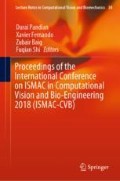Abstract
Liver tumor also known as the hepatic tumor is a type of growth found in or on the liver. Identifying the tumor location can be a tedious, error-prone and need an experts study to identify it. This paper presents a segmentation technique to segment the liver tumor using Gradient Vector Flow (GVF) snakes algorithm. To initiate snakes algorithm the images need to be insensitive to noise, Wiener Filter is proposed to remove the noise. The GVF snake starts its process by initially extending it to create an initial boundary. The GVF forces are calculated and help in driving the algorithm to stretch and bend the initial contour towards the region of interest due to the difference in intensity. The images were classified into tumor and non-tumor categories by Artificial Neural Network Classifier depending on the features extracted which showed notable dissimilarity between normal and abnormal images.
Access this chapter
Tax calculation will be finalised at checkout
Purchases are for personal use only
References
Lam KM, Yan H (1994) Fast algorithm for locating head boundaries. J Electron Imaging 3(4):352–359
Waite JB, Welsh WJ (1990) Head boundary location using snakes. Br Telecom Technol J 8(3):127–135
McInernery T, Terzopolous D (1996) Deformable models in medical image analysis: a survey. Med Image Anal 1(2):91–108
Jain AK, Smith SP, Backer E (1980) Segmentation of muscle cell pictures: a preliminary study. IEEE Trans Pattern Anal Mach Intell PAMI-2(3):232–242
Fok YL, Chan JCK, Chin RT (1996) Automated analysis of nerve cell images using active contour models. IEEE Trans Med Imaging 15(3):353–368
Ginneken B, Frangi AF, Staal JJ, Haar Romeny BM, Viergever MA (2002) Active shape model segmentation with optimal features. IEEE Trans Med Imaging 21(8):924–933
Lie WN (1995) Automatic target segmentation by locally adaptive image thresholding. IEEE Trans Image Process 4(7):1036–1041
Couvignou PA, Papanikolopoulos NP, Khosla PK (1993) On the use of snakes for 3-D robotic visual tracking. In: Proceedings of IEEE CVPR, 1993, pp 750–751
Kass M, Witkin A, Terzopoulos D (1987) Snakes: active contour models. Int J Comput Vis 1(4):321–331
Bahreini L, Fatemizadeh E, Gity M (2010) Gradient vector flow snake segmentation of breast lesions in dynamic contrast-enhanced MR images. In: 17th Iranian conference of biomedical engineering (ICBME2010), 3–4 Nov 2010, pp 1–4
Díaz-Parra A, Arana E, Moratal D (2014) Fully automatic spinal canal segmentation for radiation therapy using a gradient vector flow-based method on computed tomography images: a preliminary study. In: 2014 36th annual international conference of the IEEE 26–30 Aug 2014, Engineering in Medicine and Biology Society (EMBC), pp 5518–5521
Yuhua Y, Lixiong L, Lejian L, Ming W, Jianping G, Yinghui L (2012) Sigmoid gradient vector flow for medical image segmentation. In: 2012 IEEE 11th international conference on signal processing (ICSP) 21–25 Oct 2012, pp 881–884
Qiongfei W, Yong Z, Zhiqiang Z (2015) Infrared image segmentation based on gradient vector flow model. In: 2015 sixth international conference on intelligent systems design and engineering applications (ISDEA), pp 460–462
Mahmoud MKA, Al-Jumaily A (2011) Segmentation of skin cancer images based on gradient vector flow (GVF) snake. In: 2011 IEEE international conference on mechatronics and automation, Aug 7–10, Beijing, China, pp 216–220
Cleary K (2007) Original datasets. Midas-original datasets. doi:hdl.handle.net/1926/587
Al-Kadi OS, Chung DYF, Carlisle RC, Coussios CC, Noble JA (2014) Quantification of ultrasonic texture intra-heterogeneity via volumetric stochastic modeling for tissue characterization. Med Image Anal. https://doi.org/10.1016/j.media.2014.12.004
Grove O, Berglund AE, Schabath MB, Aerts HJ, Dekker A, Wang H, Gillies RJ (2015) Data from: quantitative computed tomographic descriptors associate tumor shape complexity and intratumor heterogeneity with prognosis in lung adenocarcinoma. Cancer Imaging Arch. https://doi.org/10.7937/k9/tcia.2015.a6v7jiwx
Gonzalez RC, Woods RE, Eddins SL (2009) Digital image processing, using MATLAB, 2nd edn. Gatesmark Publishing, USA
Pratt WK (2007) Digital image processing, 4th edn, p 16
Pratt WK (1972) Generalized wiener filtering computation techniques. IEEE Trans Comput c-21:636–641
Kass M, Witkin A, Terzopolous D (1987) Snakes: active contour models. Int J Comput 1(4):321–331
Kazerooni AF, Ahmadian A, Serej ND, Rad HS, Saberi H, Yousefi H, Farnia P (2011) Segmentation of brain tumors in MRI images using multi-scale gradient vector flow. In: 33rd annual international conference of the IEEE EMBS Boston, Massachusetts, USA, August 30–September 3, 2011, pp 7973–7976
Xu C, Prince JL (1998) Snakes, shapes, and gradient vector flow. IEEE Trans Image Process 7(3):359
Author information
Authors and Affiliations
Corresponding author
Editor information
Editors and Affiliations
Rights and permissions
Copyright information
© 2019 Springer Nature Switzerland AG
About this paper
Cite this paper
Baby, J., Rajalakshmi, T., Snekhalatha, U. (2019). Detection of Liver Tumor Using Gradient Vector Flow Algorithm. In: Pandian, D., Fernando, X., Baig, Z., Shi, F. (eds) Proceedings of the International Conference on ISMAC in Computational Vision and Bio-Engineering 2018 (ISMAC-CVB). ISMAC 2018. Lecture Notes in Computational Vision and Biomechanics, vol 30. Springer, Cham. https://doi.org/10.1007/978-3-030-00665-5_101
Download citation
DOI: https://doi.org/10.1007/978-3-030-00665-5_101
Published:
Publisher Name: Springer, Cham
Print ISBN: 978-3-030-00664-8
Online ISBN: 978-3-030-00665-5
eBook Packages: EngineeringEngineering (R0)

